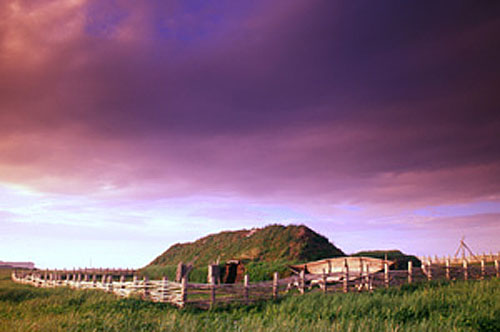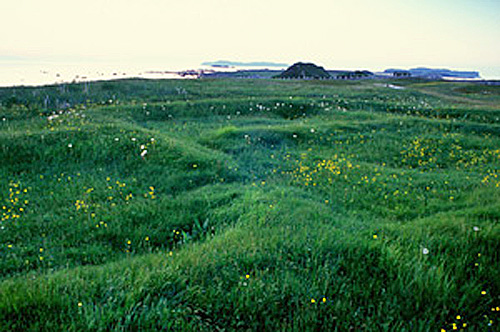L'Anse aux Meadows National Historic Site

© Dale Wilson/Parks Canada
L'Anse aux Meadows was designated a national historic site in 1968.
Commemorative plaque: 11 km north of Saint-Lunaire-Griquet, Newfoundland and LabradorFootnote 1
L'Anse aux Meadows
Discovered in 1960, this is the first authenticated Norse site found in North America and could be Leif Ericsson's short-lived Vinland camp. Some time about AD 1000 Norse seafarers established a base here from which they explored southwards. The traces of bog iron found - the first known example of iron smelting in the new world - in conjunction with evidence of carpentry suggest that boat repair was an important activity. The distance from their homelands and conflict with Native people may have led the Norse to abandon the site.
Description of historic place
L'Anse aux Meadows National Historic Site of Canada comprises the archaeological remains of an early Viking settlement situated on the eastern shore of Epaves Bay, 1 km south of the village of L'Anse aux Meadows at the tip of the Great Northern Peninsula in Newfoundland. Parks Canada has erected a partial reconstruction of the habitation for purposes of public presentation.

© Dale Wilson/Parks Canada

© Dale Wilson/Parks Canada
Heritage value
L'Anse aux Meadows was designated a national historic site of Canada because it is:
- the first known site established by Vikings in North America, and the earliest evidence of Europeans in Canada.
The heritage value of the site lies in the archaeological evidence of early Viking presence in Canada. The location, surroundings and disposition of the site together with the nature of the remains it contains provide both an essential record and legible description of Viking life on the site. In ca. 1000 AD, l'Anse aux Meadows was established as exploration base Leifsbuoir/ Straumfjord, popularly known as Leif Ericsson's short-lived Vinland camp. It has been conserved and interpreted as a national historic site of Canada.
Sources: Historic Sites and Monuments Board of Canada, 1968 Minutes; Commemorative Integrity Statement, 1998.
The National Program of Historical Commemoration relies on the participation of Canadians in the identification of places, events and persons of national historic significance. Any member of the public can nominate a topic for consideration by the Historic Sites and Monuments Board of Canada.
- Date modified :